AM7302 - Fair Value Measurement & Financial Reporting Analysis
VerifiedAdded on 2023/06/04
|6
|1434
|315
Report
AI Summary
This report critically analyzes fair value measurement under IFRS and IAS, addressing issues raised by Horton and Macve regarding its impact on financial reporting. It discusses the political and economic debates surrounding international stock exchange pricings and the flaws in the IASC's conceptual framework for fair accounting valuation. The report also examines the role of fair value measurement in the 2008 financial crisis, highlighting its weaknesses and potential for misrepresentation of financial positions. Furthermore, it explores the challenges of applying fair value standards in unstable market conditions and the resulting impact on the reliability of financial information. The report concludes by emphasizing the need for effective standards in the valuation of financial instruments to ensure accurate financial reporting and mitigate financial risks. Desklib offers a platform for students to access similar solved assignments and study resources.
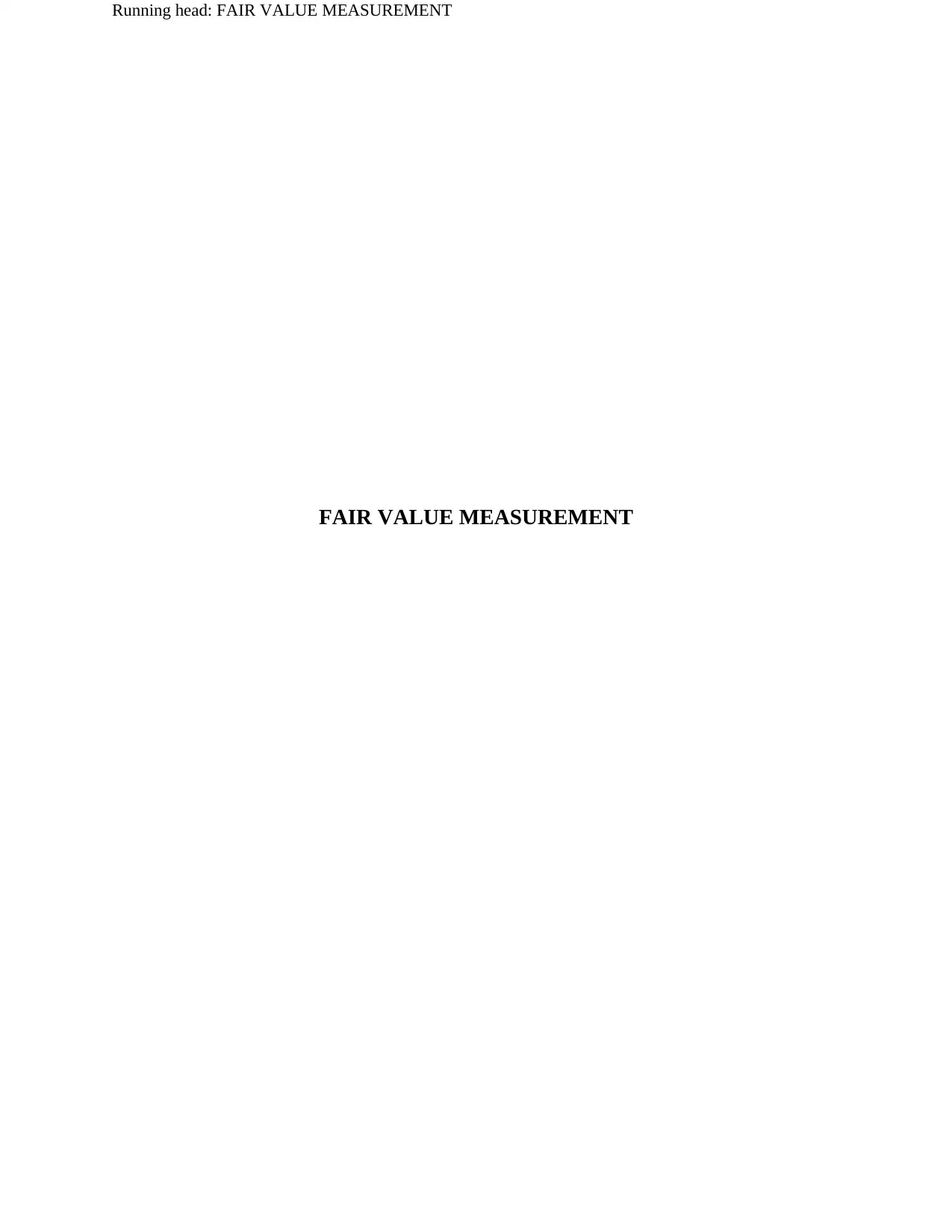
Running head: FAIR VALUE MEASUREMENT
FAIR VALUE MEASUREMENT
FAIR VALUE MEASUREMENT
Paraphrase This Document
Need a fresh take? Get an instant paraphrase of this document with our AI Paraphraser
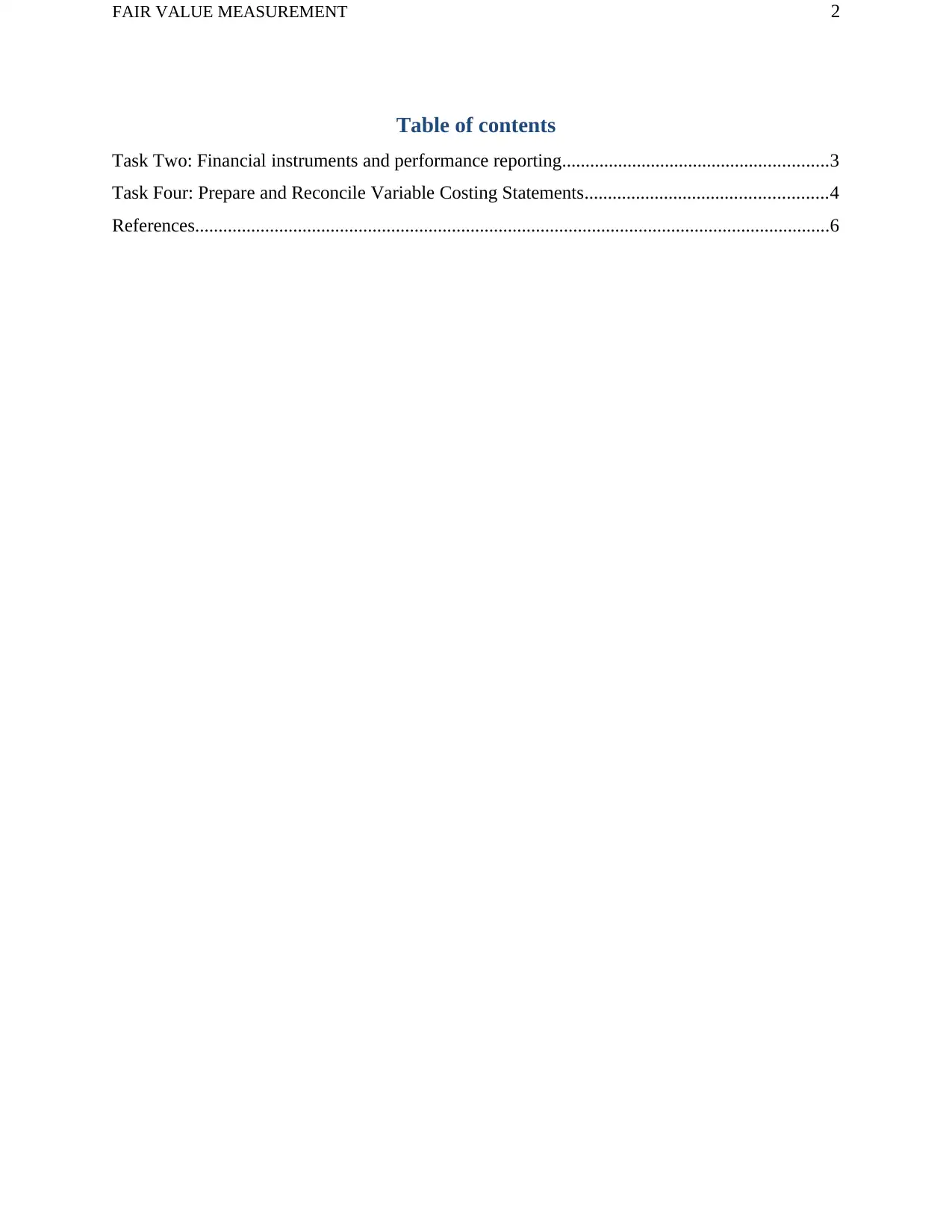
FAIR VALUE MEASUREMENT 2
Table of contents
Task Two: Financial instruments and performance reporting.........................................................3
Task Four: Prepare and Reconcile Variable Costing Statements....................................................4
References........................................................................................................................................6
Table of contents
Task Two: Financial instruments and performance reporting.........................................................3
Task Four: Prepare and Reconcile Variable Costing Statements....................................................4
References........................................................................................................................................6
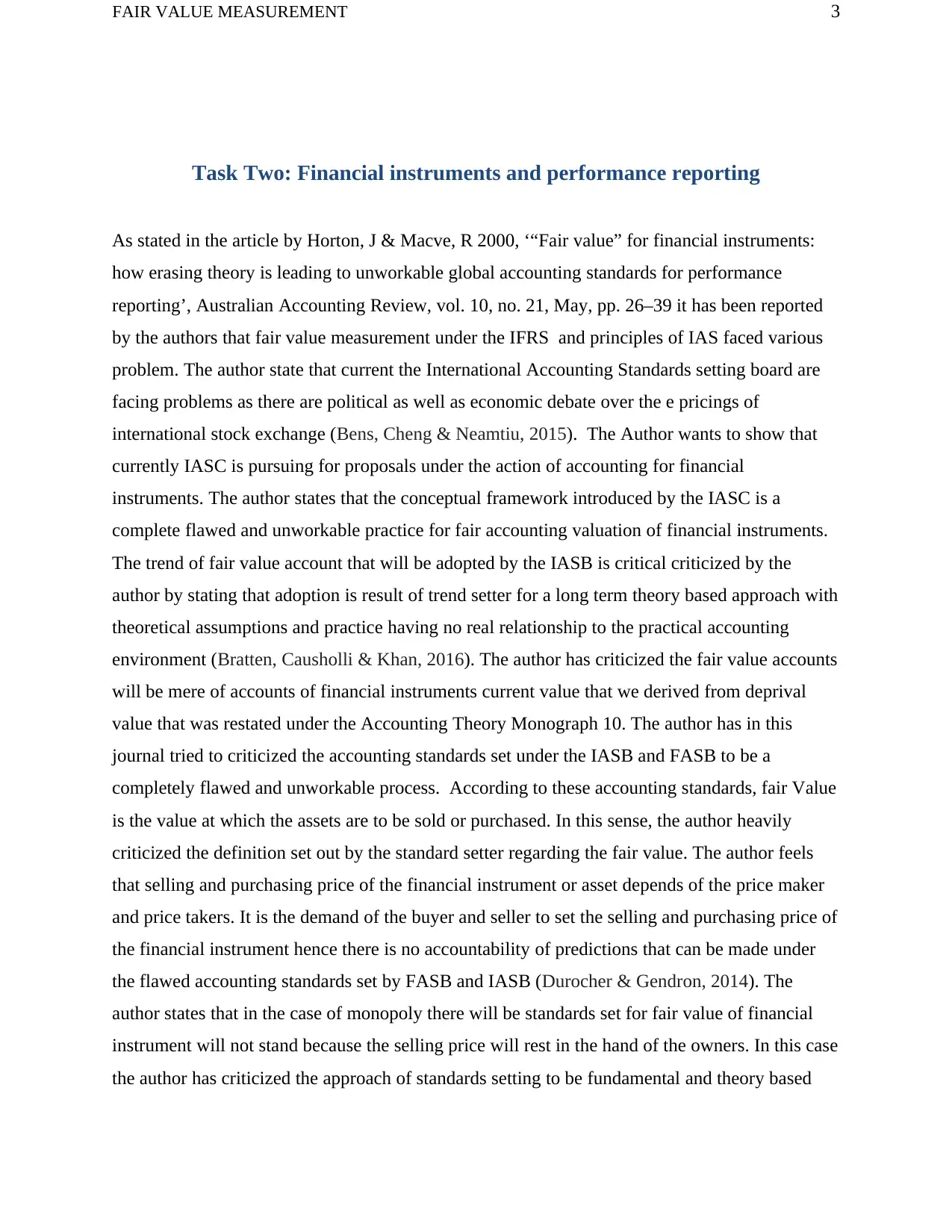
FAIR VALUE MEASUREMENT 3
Task Two: Financial instruments and performance reporting
As stated in the article by Horton, J & Macve, R 2000, ‘“Fair value” for financial instruments:
how erasing theory is leading to unworkable global accounting standards for performance
reporting’, Australian Accounting Review, vol. 10, no. 21, May, pp. 26–39 it has been reported
by the authors that fair value measurement under the IFRS and principles of IAS faced various
problem. The author state that current the International Accounting Standards setting board are
facing problems as there are political as well as economic debate over the e pricings of
international stock exchange (Bens, Cheng & Neamtiu, 2015). The Author wants to show that
currently IASC is pursuing for proposals under the action of accounting for financial
instruments. The author states that the conceptual framework introduced by the IASC is a
complete flawed and unworkable practice for fair accounting valuation of financial instruments.
The trend of fair value account that will be adopted by the IASB is critical criticized by the
author by stating that adoption is result of trend setter for a long term theory based approach with
theoretical assumptions and practice having no real relationship to the practical accounting
environment (Bratten, Causholli & Khan, 2016). The author has criticized the fair value accounts
will be mere of accounts of financial instruments current value that we derived from deprival
value that was restated under the Accounting Theory Monograph 10. The author has in this
journal tried to criticized the accounting standards set under the IASB and FASB to be a
completely flawed and unworkable process. According to these accounting standards, fair Value
is the value at which the assets are to be sold or purchased. In this sense, the author heavily
criticized the definition set out by the standard setter regarding the fair value. The author feels
that selling and purchasing price of the financial instrument or asset depends of the price maker
and price takers. It is the demand of the buyer and seller to set the selling and purchasing price of
the financial instrument hence there is no accountability of predictions that can be made under
the flawed accounting standards set by FASB and IASB (Durocher & Gendron, 2014). The
author states that in the case of monopoly there will be standards set for fair value of financial
instrument will not stand because the selling price will rest in the hand of the owners. In this case
the author has criticized the approach of standards setting to be fundamental and theory based
Task Two: Financial instruments and performance reporting
As stated in the article by Horton, J & Macve, R 2000, ‘“Fair value” for financial instruments:
how erasing theory is leading to unworkable global accounting standards for performance
reporting’, Australian Accounting Review, vol. 10, no. 21, May, pp. 26–39 it has been reported
by the authors that fair value measurement under the IFRS and principles of IAS faced various
problem. The author state that current the International Accounting Standards setting board are
facing problems as there are political as well as economic debate over the e pricings of
international stock exchange (Bens, Cheng & Neamtiu, 2015). The Author wants to show that
currently IASC is pursuing for proposals under the action of accounting for financial
instruments. The author states that the conceptual framework introduced by the IASC is a
complete flawed and unworkable practice for fair accounting valuation of financial instruments.
The trend of fair value account that will be adopted by the IASB is critical criticized by the
author by stating that adoption is result of trend setter for a long term theory based approach with
theoretical assumptions and practice having no real relationship to the practical accounting
environment (Bratten, Causholli & Khan, 2016). The author has criticized the fair value accounts
will be mere of accounts of financial instruments current value that we derived from deprival
value that was restated under the Accounting Theory Monograph 10. The author has in this
journal tried to criticized the accounting standards set under the IASB and FASB to be a
completely flawed and unworkable process. According to these accounting standards, fair Value
is the value at which the assets are to be sold or purchased. In this sense, the author heavily
criticized the definition set out by the standard setter regarding the fair value. The author feels
that selling and purchasing price of the financial instrument or asset depends of the price maker
and price takers. It is the demand of the buyer and seller to set the selling and purchasing price of
the financial instrument hence there is no accountability of predictions that can be made under
the flawed accounting standards set by FASB and IASB (Durocher & Gendron, 2014). The
author states that in the case of monopoly there will be standards set for fair value of financial
instrument will not stand because the selling price will rest in the hand of the owners. In this case
the author has criticized the approach of standards setting to be fundamental and theory based
⊘ This is a preview!⊘
Do you want full access?
Subscribe today to unlock all pages.

Trusted by 1+ million students worldwide
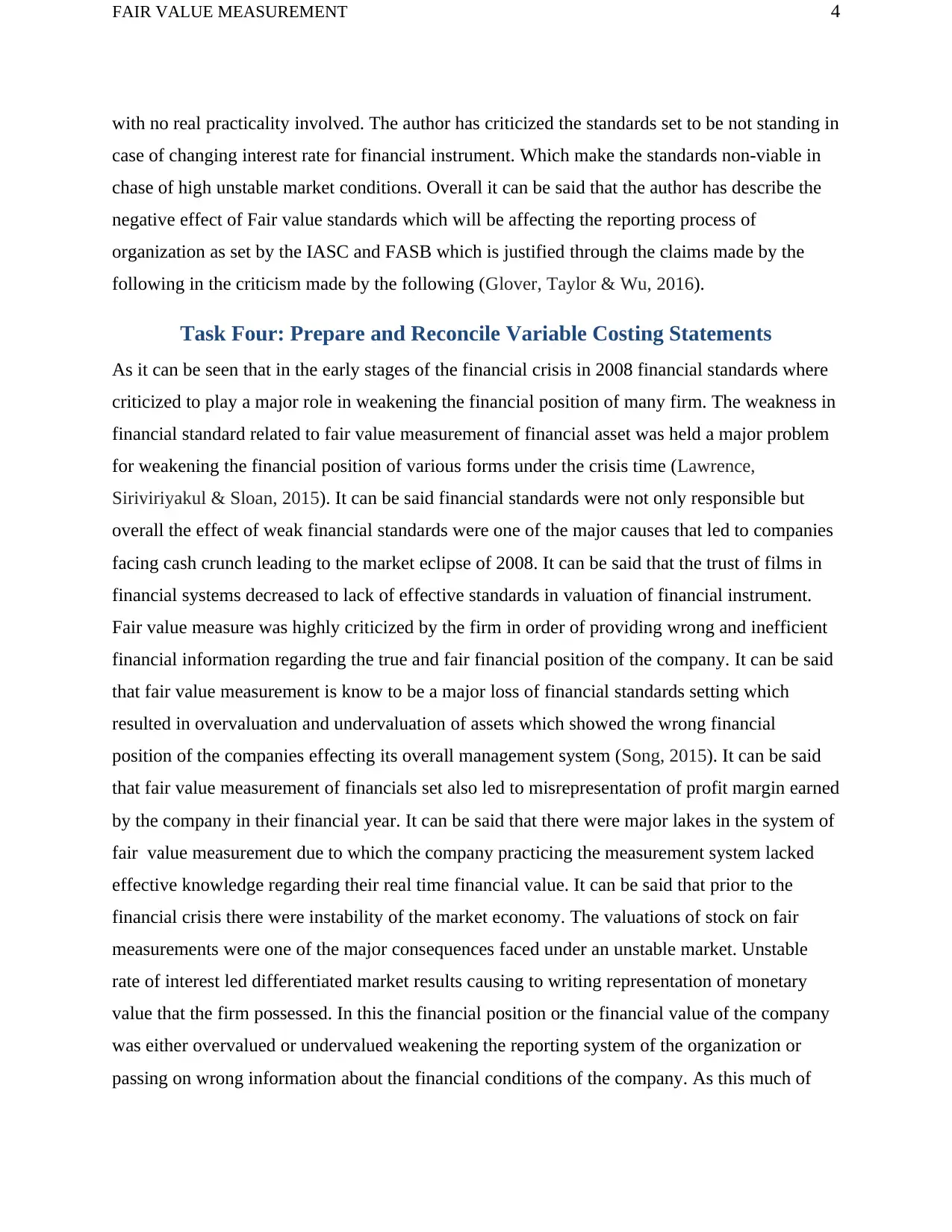
FAIR VALUE MEASUREMENT 4
with no real practicality involved. The author has criticized the standards set to be not standing in
case of changing interest rate for financial instrument. Which make the standards non-viable in
chase of high unstable market conditions. Overall it can be said that the author has describe the
negative effect of Fair value standards which will be affecting the reporting process of
organization as set by the IASC and FASB which is justified through the claims made by the
following in the criticism made by the following (Glover, Taylor & Wu, 2016).
Task Four: Prepare and Reconcile Variable Costing Statements
As it can be seen that in the early stages of the financial crisis in 2008 financial standards where
criticized to play a major role in weakening the financial position of many firm. The weakness in
financial standard related to fair value measurement of financial asset was held a major problem
for weakening the financial position of various forms under the crisis time (Lawrence,
Siriviriyakul & Sloan, 2015). It can be said financial standards were not only responsible but
overall the effect of weak financial standards were one of the major causes that led to companies
facing cash crunch leading to the market eclipse of 2008. It can be said that the trust of films in
financial systems decreased to lack of effective standards in valuation of financial instrument.
Fair value measure was highly criticized by the firm in order of providing wrong and inefficient
financial information regarding the true and fair financial position of the company. It can be said
that fair value measurement is know to be a major loss of financial standards setting which
resulted in overvaluation and undervaluation of assets which showed the wrong financial
position of the companies effecting its overall management system (Song, 2015). It can be said
that fair value measurement of financials set also led to misrepresentation of profit margin earned
by the company in their financial year. It can be said that there were major lakes in the system of
fair value measurement due to which the company practicing the measurement system lacked
effective knowledge regarding their real time financial value. It can be said that prior to the
financial crisis there were instability of the market economy. The valuations of stock on fair
measurements were one of the major consequences faced under an unstable market. Unstable
rate of interest led differentiated market results causing to writing representation of monetary
value that the firm possessed. In this the financial position or the financial value of the company
was either overvalued or undervalued weakening the reporting system of the organization or
passing on wrong information about the financial conditions of the company. As this much of
with no real practicality involved. The author has criticized the standards set to be not standing in
case of changing interest rate for financial instrument. Which make the standards non-viable in
chase of high unstable market conditions. Overall it can be said that the author has describe the
negative effect of Fair value standards which will be affecting the reporting process of
organization as set by the IASC and FASB which is justified through the claims made by the
following in the criticism made by the following (Glover, Taylor & Wu, 2016).
Task Four: Prepare and Reconcile Variable Costing Statements
As it can be seen that in the early stages of the financial crisis in 2008 financial standards where
criticized to play a major role in weakening the financial position of many firm. The weakness in
financial standard related to fair value measurement of financial asset was held a major problem
for weakening the financial position of various forms under the crisis time (Lawrence,
Siriviriyakul & Sloan, 2015). It can be said financial standards were not only responsible but
overall the effect of weak financial standards were one of the major causes that led to companies
facing cash crunch leading to the market eclipse of 2008. It can be said that the trust of films in
financial systems decreased to lack of effective standards in valuation of financial instrument.
Fair value measure was highly criticized by the firm in order of providing wrong and inefficient
financial information regarding the true and fair financial position of the company. It can be said
that fair value measurement is know to be a major loss of financial standards setting which
resulted in overvaluation and undervaluation of assets which showed the wrong financial
position of the companies effecting its overall management system (Song, 2015). It can be said
that fair value measurement of financials set also led to misrepresentation of profit margin earned
by the company in their financial year. It can be said that there were major lakes in the system of
fair value measurement due to which the company practicing the measurement system lacked
effective knowledge regarding their real time financial value. It can be said that prior to the
financial crisis there were instability of the market economy. The valuations of stock on fair
measurements were one of the major consequences faced under an unstable market. Unstable
rate of interest led differentiated market results causing to writing representation of monetary
value that the firm possessed. In this the financial position or the financial value of the company
was either overvalued or undervalued weakening the reporting system of the organization or
passing on wrong information about the financial conditions of the company. As this much of
Paraphrase This Document
Need a fresh take? Get an instant paraphrase of this document with our AI Paraphraser

FAIR VALUE MEASUREMENT 5
wrong information is passed through process it was not able for the management mitigate the
situation of financial crunch within the firm (de Jager, 2014.). This leads to financial downfall of
the organization in the economy as well as financial crisis within the market. It can be said that
the firm were not able to identify their real financial position due to which identification of
possible financial measure was not taken. All of these sequences lead to error in judgment
causing financial problems within a firm and decrease cash value of the former. Thus, it can be
said fair value measurement is one of the major contributor to the financial crisis in the year
2008.
wrong information is passed through process it was not able for the management mitigate the
situation of financial crunch within the firm (de Jager, 2014.). This leads to financial downfall of
the organization in the economy as well as financial crisis within the market. It can be said that
the firm were not able to identify their real financial position due to which identification of
possible financial measure was not taken. All of these sequences lead to error in judgment
causing financial problems within a firm and decrease cash value of the former. Thus, it can be
said fair value measurement is one of the major contributor to the financial crisis in the year
2008.
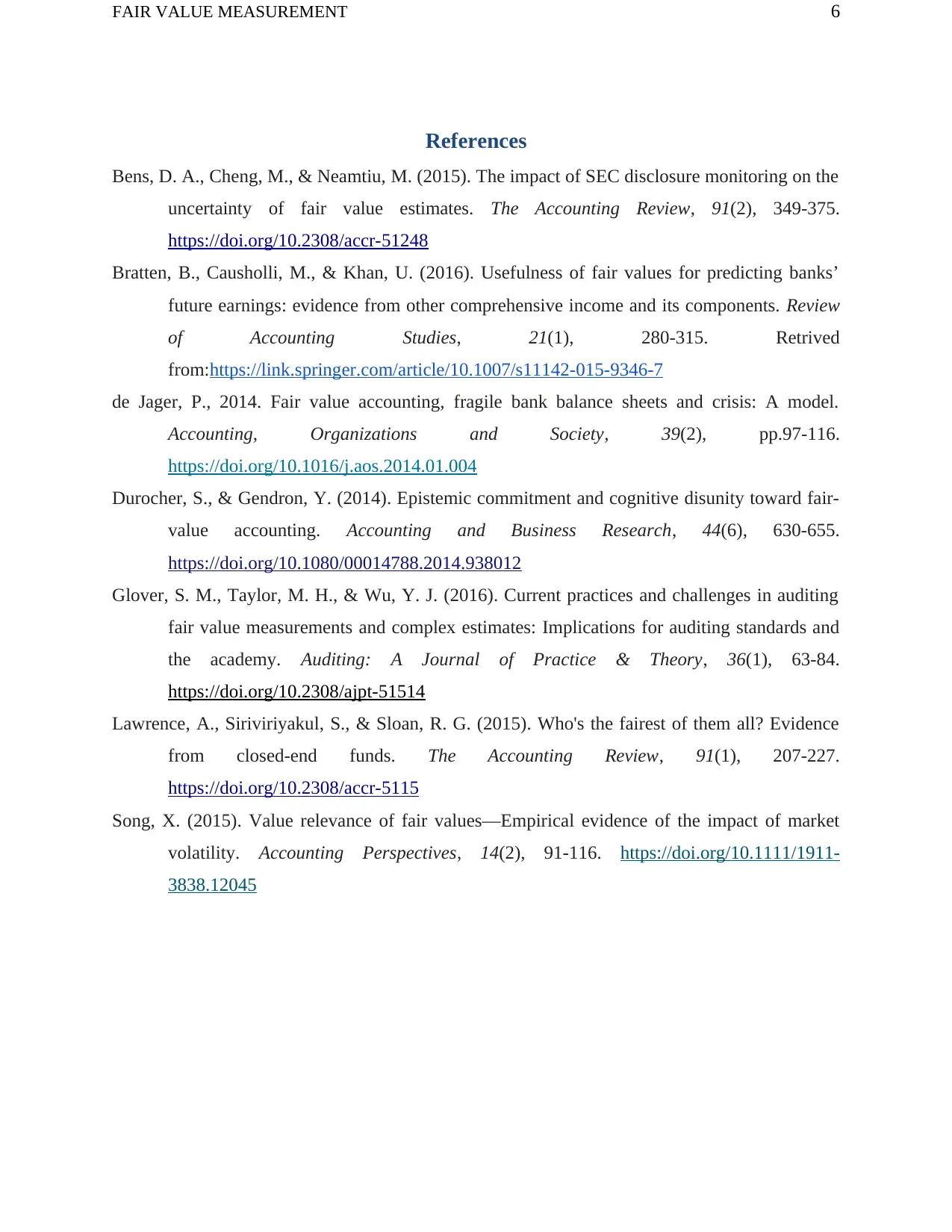
FAIR VALUE MEASUREMENT 6
References
Bens, D. A., Cheng, M., & Neamtiu, M. (2015). The impact of SEC disclosure monitoring on the
uncertainty of fair value estimates. The Accounting Review, 91(2), 349-375.
https://doi.org/10.2308/accr-51248
Bratten, B., Causholli, M., & Khan, U. (2016). Usefulness of fair values for predicting banks’
future earnings: evidence from other comprehensive income and its components. Review
of Accounting Studies, 21(1), 280-315. Retrived
from:https://link.springer.com/article/10.1007/s11142-015-9346-7
de Jager, P., 2014. Fair value accounting, fragile bank balance sheets and crisis: A model.
Accounting, Organizations and Society, 39(2), pp.97-116.
https://doi.org/10.1016/j.aos.2014.01.004
Durocher, S., & Gendron, Y. (2014). Epistemic commitment and cognitive disunity toward fair-
value accounting. Accounting and Business Research, 44(6), 630-655.
https://doi.org/10.1080/00014788.2014.938012
Glover, S. M., Taylor, M. H., & Wu, Y. J. (2016). Current practices and challenges in auditing
fair value measurements and complex estimates: Implications for auditing standards and
the academy. Auditing: A Journal of Practice & Theory, 36(1), 63-84.
https://doi.org/10.2308/ajpt-51514
Lawrence, A., Siriviriyakul, S., & Sloan, R. G. (2015). Who's the fairest of them all? Evidence
from closed-end funds. The Accounting Review, 91(1), 207-227.
https://doi.org/10.2308/accr-5115
Song, X. (2015). Value relevance of fair values—Empirical evidence of the impact of market
volatility. Accounting Perspectives, 14(2), 91-116. https://doi.org/10.1111/1911-
3838.12045
References
Bens, D. A., Cheng, M., & Neamtiu, M. (2015). The impact of SEC disclosure monitoring on the
uncertainty of fair value estimates. The Accounting Review, 91(2), 349-375.
https://doi.org/10.2308/accr-51248
Bratten, B., Causholli, M., & Khan, U. (2016). Usefulness of fair values for predicting banks’
future earnings: evidence from other comprehensive income and its components. Review
of Accounting Studies, 21(1), 280-315. Retrived
from:https://link.springer.com/article/10.1007/s11142-015-9346-7
de Jager, P., 2014. Fair value accounting, fragile bank balance sheets and crisis: A model.
Accounting, Organizations and Society, 39(2), pp.97-116.
https://doi.org/10.1016/j.aos.2014.01.004
Durocher, S., & Gendron, Y. (2014). Epistemic commitment and cognitive disunity toward fair-
value accounting. Accounting and Business Research, 44(6), 630-655.
https://doi.org/10.1080/00014788.2014.938012
Glover, S. M., Taylor, M. H., & Wu, Y. J. (2016). Current practices and challenges in auditing
fair value measurements and complex estimates: Implications for auditing standards and
the academy. Auditing: A Journal of Practice & Theory, 36(1), 63-84.
https://doi.org/10.2308/ajpt-51514
Lawrence, A., Siriviriyakul, S., & Sloan, R. G. (2015). Who's the fairest of them all? Evidence
from closed-end funds. The Accounting Review, 91(1), 207-227.
https://doi.org/10.2308/accr-5115
Song, X. (2015). Value relevance of fair values—Empirical evidence of the impact of market
volatility. Accounting Perspectives, 14(2), 91-116. https://doi.org/10.1111/1911-
3838.12045
⊘ This is a preview!⊘
Do you want full access?
Subscribe today to unlock all pages.

Trusted by 1+ million students worldwide
1 out of 6
Related Documents
Your All-in-One AI-Powered Toolkit for Academic Success.
+13062052269
info@desklib.com
Available 24*7 on WhatsApp / Email
![[object Object]](/_next/static/media/star-bottom.7253800d.svg)
Unlock your academic potential
Copyright © 2020–2025 A2Z Services. All Rights Reserved. Developed and managed by ZUCOL.




